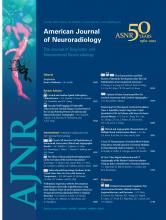Abstract
BACKGROUND AND PURPOSE: Development of a headache after aneurysm coil embolization is not uncommon but has received little attention. The authors prospectively analyze the characteristics and risk factors of a headache after coiling in patients treated for an unruptured cerebral aneurysm.
MATERIALS AND METHODS: Ninety patients treated for an unruptured cerebral aneurysm over a period of 1 year, and without a headache history within a month before coiling, were enrolled in this study. All coilings were successfully performed without neurologic complications. After coiling, headache development and intensities were recorded.
RESULTS: Fifty (55.6%) patients experienced a headache (VAS score, 4.5 ± 2.02) at 7.9 (range, 0–72) hours, on average, after coiling, and all headaches resolved within an average of 73.0 (range, 3–312) hours. Univariate analysis showed that the following were significantly associated with the development of a headache: age ≤50 years (OR 4.636, 95% CI, 1.414–15.198), hypertension (OR 0.232, 95% CI, 0.095–0.571), a packing attenuation of >25% (OR 3.619, 95% CI, 1.428–9.174), and a previous headache history (OR 2.769, 95% CI, 1.120–6.849). However, binary logistic regression showed that only a packing attenuation of >25% (P = .013, adjusted OR 3.774, 95% CI, 1.320–10.790) and no history of hypertension (P = .019, adjusted OR 3.515, 95% CI, 1.233–10.021) were independently associated with the development of a headache.
CONCLUSIONS: A headache frequently developed after the coiling of unruptured aneurysms. However, headaches were relatively benign and resolved within several days. The present study shows that no hypertension history and a packing attenuation of >25% are risk factors of headache development.
ABBREVIATIONS:
- CI
- confidence interval
- NSAID
- nonsteroidal anti-inflammatory drug
- OR
- odds ratio
- VAS
- Visual Analogue Scale
- © 2012 by American Journal of Neuroradiology
Indicates open access to non-subscribers at www.ajnr.org












